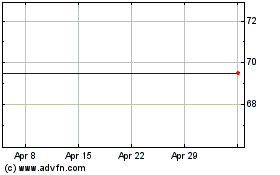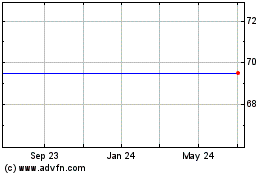Ball Aerospace Completes CDR for Landsat's Operational Land Imager
November 25 2008 - 8:05AM
PR Newswire (US)
BOULDER, Colo., Nov. 25 /PRNewswire-FirstCall/ -- The Operational
Land Imager (OLI) being built by Ball Aerospace & Technologies
Corp. for the Landsat Data Continuity Mission (LDCM), the eighth in
the Landsat satellite series, has successfully passed the
Instrument Critical Design Review (ICDR). The ICDR, a four-day
process in Boulder, included more than 60 representatives from
NASA's Goddard Space Flight Center project office and review team;
members of the Landsat Data Continuity Mission (LDCM) Independent
Review Board; Landsat scientists from the United States Geological
Survey; and industry participants. The team reviewed OLI systems
architecture, as well as detailed analysis of integration and the
test approach including validation and calibration. "We are focused
on delivering an advanced instrument to support the government's
continuation of the vital Landsat program," said David L. Taylor,
president and CEO of Ball Aerospace. "Successful on-time completion
of OLI will further complement Ball's strong legacy in both Earth
science and remote-sensing missions." ICDR participants noted
Ball's heritage from similar instruments in congratulating the OLI
team for retiring major risks and moving well beyond ICDR in most
areas. The OLI instrument provides 15-meter (49ft.) panchromatic
and 30m multi-spectral Earth-imaging spatial-resolution capability.
OLI includes a 185km swath allowing the entire globe to be imaged
every 16 days. The Landsat Program is a series of Earth-observing
satellite missions jointly managed by NASA and the U.S. Geological
Survey (USGS). For more than 36 years, Landsat satellites have
continuously and consistently collected images of Earth, creating a
historical archive unmatched in quality, detail, coverage and
length. The multispectral imagery is gathered for applications that
include agricultural monitoring, natural resource management and
land-use planning. Ball Aerospace & Technologies Corp. supports
critical missions of important national agencies such as the
Department of Defense, NASA, NOAA and other U.S. government and
commercial entities. The company develops and manufactures
spacecraft, advanced instruments and sensors, components, data
exploitation systems and RF solutions for strategic, tactical and
scientific applications. Since 1956, Ball Aerospace has been
responsible for numerous technological and scientific 'firsts' and
acts as a technology innovator for the aerospace market. Ball
Corporation (NYSE:BLL) is a supplier of high-quality metal and
plastic packaging products for beverage, food and household
products customers, and of aerospace and other technologies and
services, primarily for the U.S. government. Ball Corporation and
its subsidiaries employ more than 15,000 people worldwide and
reported 2007 sales of $7.4 billion. Forward Looking Statements
This release contains "forward-looking" statements concerning
future events and financial performance. Words such as "expects,"
"anticipates," "estimates" and similar expressions are intended to
identify forward-looking statements. Such statements are subject to
risks and uncertainties which could cause actual results to differ
materially from those expressed or implied. The company undertakes
no obligation to publicly update or revise any forward-looking
statements, whether as a result of new information, future events
or otherwise. Key risks and uncertainties are summarized in filings
with the Securities and Exchange Commission, including Exhibit 99.2
in our Form 10-K, which are available at our Web site and at
http://www.sec.gov/. Factors that might affect our packaging
segments include fluctuation in product demand and preferences;
availability and cost of raw materials, including recent
significant increases in resin, steel, aluminum and energy costs,
and the ability to pass such increases on to customers; competitive
packaging availability, pricing and substitution; changes in
climate and weather; crop yields; competitive activity; failure to
achieve anticipated productivity improvements or production cost
reductions, including our beverage can end project; mandatory
deposit or other restrictive packaging laws; changes in major
customer or supplier contracts or loss of a major customer or
supplier; and changes in foreign exchange rates, tax rates and
activities of foreign subsidiaries. Factors that might affect our
aerospace segment include: funding, authorization, availability and
returns of government and commercial contracts; and delays,
extensions and technical uncertainties affecting segment contracts.
Factors that might affect the company as a whole include those
listed plus: accounting changes; changes in senior management; the
current global credit squeeze and its effects on liquidity, credit
risk, asset values and the economy; successful or unsuccessful
acquisitions, joint ventures or divestitures; integration of
recently acquired businesses; regulatory action or laws including
tax, environmental, health and workplace safety, including in
respect of chemicals or substances used in raw materials or in the
manufacturing process; governmental investigations; technological
developments and innovations; goodwill impairment; antitrust,
patent and other litigation; strikes; labor cost changes; rates of
return projected and earned on assets of the company's defined
benefit retirement plans; pension changes; reduced cash flow;
interest rates affecting our debt; and changes to unaudited results
due to statutory audits or other effects. DATASOURCE: Ball
Aerospace & Technologies Corp. CONTACT: Roz Brown of Ball
Aerospace & Technologies Corp., +1-303-533-6059, Web Site:
http://www.ballaerospace.com/
Copyright
Ball (NYSE:BLL)
Historical Stock Chart
From May 2024 to Jun 2024

Ball (NYSE:BLL)
Historical Stock Chart
From Jun 2023 to Jun 2024
